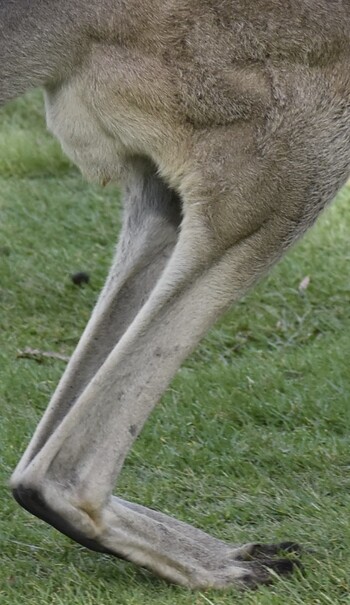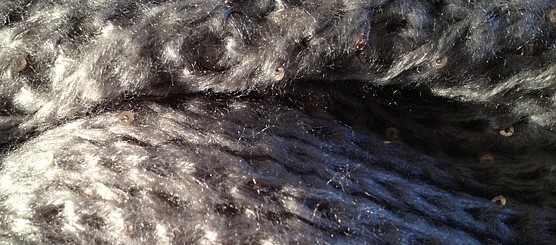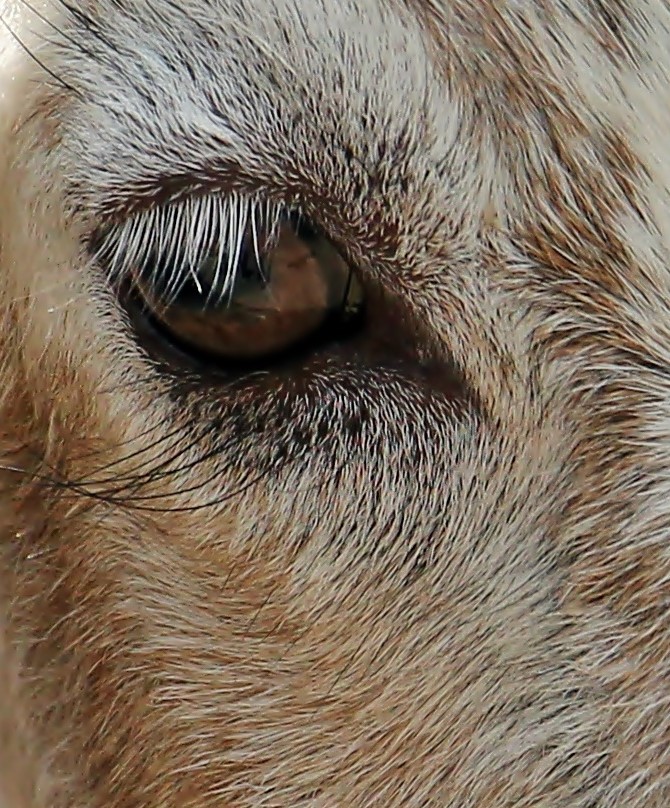Ghat
The Ghat is a domesticated and wild six legged Bipod that lives in large herds in the Noshar Desert and the Plains of Tern. It intially was a migratory species and many people still follow the Ghat herds.
Basic Information
Anatomy
Ghats are six legged creatures with a bulky sharply angled pair of middle legs with four smaller front and back legs. The front legs have a small Cresent and Moon hoof with the moon sharpened into a point. On the back legs the moon has shrunk to a vestigial structure and the legs only have a crescent footpad.
Ghats are covered in a outer layer of straight fine light colored fur about 10 cm in length. Depending on the breed can range from a solid white to a dappled light brown. During the Day. During the noontime winds the fine blowing fur gives the impression of a shimmering coat in constant motion. The undercoat of fur is only about 2-4 cm in length and usually an dark brown or black. In the day time this dark undercoat is hidden by the fine light outer coat.
When temperatures reach about 4-5 C, the outer fur undergoes a remarkable transformation. The fur curls and winds together forming a dense coat of fur to trap in heat. The fur also becomes translucent allowing the dark undercoat to show through. Additionally as the outer coat curls in shrinks in length the under coat becomes longer then the outercoat and its dark fibers become twisted in the curling outer coat. This means that as the temperature changes the Ghats fur become much more efficient at trapping heat and darkens dramatically, allowing the Ghats to soak up the setting and rising suns heat as well as providing camouflage during the night. The curling property of Ghat fur make Ghat wool a valuable resource that is collected from Ghats.
Genetics and Reproduction
Ghats live in packs dominated by a masc ghat who leads his harem around the plains. In excahnge for protection the fem ghats are forced to give up a percentage of the gheeg they produce. Ghats are naturally hermaphroditic creatures with two distinct sexual dimorphisms. The fem form is the default form that a ghat takes, with female reproductive organs active and the male organs are inactive. Ghat can determine the sexual dimorphism of thier offspring by feeding them Gheegs with slightly different signaling compounds. Slightly more that half of ghats develop into the Fem form, but if a mother feels like she has a particular strong ghat, she will make him develop into a masc ghat. Then they would compete for there own harem. Additionally the repeated stress of losing a contest for a harem can trigger a masc ghast to switch to the fem form. Herds that lose thier masc ghast have been replaced by a formerly fem ghast trasforming into a masc.
Fem ghats gestate for 1.5 days and give birth to live young in the morning of the day before they start their daily mirgration following the noontime rains. Since young ghasts are expected to make the migration when only an Ides Cycle old, they are born strong and ready to run and walk for long periods of time. They don't have to graze for food during thier first migration, their mother feed them extra nutrious gheegs. Cultures that rasie domestic ghats will either slaughter a large proportion of the baby ghats right away for meat and then collect the extra gheegs for food. If food is plentiful, tribes will let the babies grow up and then slughter the adults for meat. This produces more meat but at the exense of fewer calories per pound of vegatation a ghat eats.
Ecology and Habitats
Ghats are migratory creatures that follow the noontime rains on the Noshar Desert. In the midmoring the rains begin and the first vegatation starts to grow. After a sufficeint amount of rain falls, the plants spring to life and the ghats begin shearching for the fresh vegation. The roam very widely hunting for the best vegatation, and producing gheegs which they cache on thier route. Their genral migration is in a eastward direction. The sun also travels in an eastward direction as well but at a faster speed. Thus as the ghats are migrating the noontime storms overtakes them and the afternoon storms start. By the time the sun and afternoon storms pass them by the Ghats will have traveled 1000-2000 km in a eastward direction moving with a speed of about 10-30 miles in an earth day. This migration means that they spend about 40% more time in the rainy season. As the afternoon rains pass by the ghat are now in the Plains of Tern area, an area much richer in plant vegatation. They spend the dry late afternoon eating lush grassland vegatation fattening up for the trek back across the nighttime desert.
As the nightime comes and the temperatures drop the ghats retrace their migration route finding the caches of gheegs that they had stored along the way. This time they only move 5-10 miles every earth day. They time their arrvial back at their starting location to coinside with the early morning and rising temperature. They spend the next two Ides Cycles giving birth and trainning the young for the first migration, which begins whenever the first midmorning rains stimulate the deresert vegatation growth.
Dietary Needs and Habits
Ghats are herbavorious that eat most of the plant life in the deresert. They follow the rains and produce gheegs, a sweet nutrionally balanced honey like substance protected by hard shell. They cache these gheegs for the return trip made in the frigid cold night when no vegatation is growing.
Additional Information
Domestication
Scholars suspect that the Ghat was one of the first species domesticated on didome. They suspect that the Ghat was domesticated by capturing a young Ghat and raising it masc and getting it used to humans. Then the humans would help it win control a harem and follow the harem around which was now led by a human acustomed ghat. Humans would then selectivly cull the herd of the ghats most frightened of humans. After many generations of this the Ghat became domesticated and used to the presence of humans. All the humans had to do was make sure the Masc Ghat remained in charge and was tame enough to be controlled.
Uses, Products & Exploitation
Ghats produce Gheegs which are a staple food of the people descended from the Tern Tribes, and thier meat is a staple protien. However, not everyone can eat the meat and gheegs, people who are Carnick get nauseous and stomach cramps if they eat the meat and gheegs. If the meat is slow cook for a very long time they can eat the food.
Ghat wool is also highly valued for its ability to curl when cooled. Ghat wool garments knitted in warm enviroments will shrink when exposed to cold, and garments knitted in the cold will loose when warmed up.
Genetic Ancestor(s)
Scientific Name
BIpod Ghatian
Lifespan
30 days
Average Height
A Ghat stands about 1.1 meters tall at its center back directly below its mid legs.
Average Weight
80 kg
Average Length
A Ghat is 1.4 meters long from head to base of tail. They also have a 0.7 meter tail
Geographic Distribution





Comments